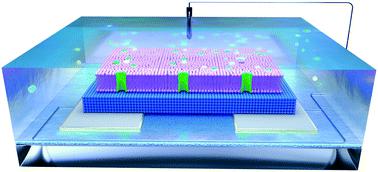当前位置:
X-MOL 学术
›
Mater. Horiz.
›
论文详情
Our official English website, www.x-mol.net, welcomes your
feedback! (Note: you will need to create a separate account there.)
Monitoring supported lipid bilayers with n-type organic electrochemical transistors
Materials Horizons ( IF 12.2 ) Pub Date : 2020-06-11 , DOI: 10.1039/d0mh00548g Malak Kawan 1, 2, 3, 4 , Tania C. Hidalgo 1, 2, 3, 4 , Weiyuan Du 4, 5, 6, 7 , Anna-Maria Pappa 8, 9, 10 , Róisín M. Owens 8, 9, 10 , Iain McCulloch 4, 5, 6, 7, 11 , Sahika Inal 1, 2, 3, 4
Materials Horizons ( IF 12.2 ) Pub Date : 2020-06-11 , DOI: 10.1039/d0mh00548g Malak Kawan 1, 2, 3, 4 , Tania C. Hidalgo 1, 2, 3, 4 , Weiyuan Du 4, 5, 6, 7 , Anna-Maria Pappa 8, 9, 10 , Róisín M. Owens 8, 9, 10 , Iain McCulloch 4, 5, 6, 7, 11 , Sahika Inal 1, 2, 3, 4
Affiliation

|
Supported lipid bilayers (SLBs) have emerged as powerful model systems to study various membrane-governed cellular events. Conducting polymers are excellent materials to establish electrical communication with SLBs. However, forming SLBs that are defect-free on the existing library of electronic polymer films, which have not been designed to interface lipids, remains a challenge. Moreover, the existing polymers are predominantly p-type conductors, hindering the development of devices that can be superior to current technologies. In this work, we synthesized an n-type semiconducting polymer based on a naphthalene 1,4,5,8 tetracarboxylic diimide bithiophene (NDI-T2) backbone functionalized with bio-inspired, lysine-based side chains (L2). The lysine chains, that are oriented on the surface of the film, facilitated the assembly of the zwitterionic lipid vesicles into an SLB. The n-type polymer also proved to be an ideal channel material for the state-of-the-art bioelectronic transducer, i.e., organic electrochemical transistor (OECT). We used the n-type, accumulation mode OECTs to assess the quality of the SLB as well as to monitor the activity of a pore forming protein integrated into the SLB. Our work marks the first demonstration of a bio-functionalized n-type polymer, specifically designed for interfacing the lipid membrane, alongside the high operational stability in biologically relevant electrolytes and sufficient performance in microscale transistors for biosensing applications.
中文翻译:

使用n型有机电化学晶体管监控支持的脂质双层
受支持的脂质双层(SLB)已成为研究各种膜调控细胞事件的强大模型系统。导电聚合物是与SLB建立电连通的绝佳材料。但是,在现有的电子聚合物薄膜库中形成无缺陷的SLB(尚未设计成与脂质接触)仍然是一个挑战。此外,现有的聚合物主要是p型导体,阻碍了可以优于当前技术的器件的开发。在这项工作中,我们合成了一种基于萘1,4,5,8四羧酸二酰亚胺联噻吩(NDI-T2)骨架的n型半导体聚合物,该骨架被生物启发的基于赖氨酸的侧链(L2)官能化。赖氨酸链位于薄膜表面,促进两性离子脂质囊泡组装成SLB。N型聚合物还被证明是最先进的生物电子换能器的理想通道材料,即有机电化学晶体管(OECT)。我们使用n型累积模式OECTs评估SLB的质量,并监测整合到SLB中的成孔蛋白的活性。我们的工作标志着生物功能化的n型聚合物的首次展示,该聚合物专门设计用于连接脂质膜,同时在生物相关电解质中具有很高的操作稳定性,并在生物传感应用的微型晶体管中具有足够的性能。
更新日期:2020-06-11
中文翻译:

使用n型有机电化学晶体管监控支持的脂质双层
受支持的脂质双层(SLB)已成为研究各种膜调控细胞事件的强大模型系统。导电聚合物是与SLB建立电连通的绝佳材料。但是,在现有的电子聚合物薄膜库中形成无缺陷的SLB(尚未设计成与脂质接触)仍然是一个挑战。此外,现有的聚合物主要是p型导体,阻碍了可以优于当前技术的器件的开发。在这项工作中,我们合成了一种基于萘1,4,5,8四羧酸二酰亚胺联噻吩(NDI-T2)骨架的n型半导体聚合物,该骨架被生物启发的基于赖氨酸的侧链(L2)官能化。赖氨酸链位于薄膜表面,促进两性离子脂质囊泡组装成SLB。N型聚合物还被证明是最先进的生物电子换能器的理想通道材料,即有机电化学晶体管(OECT)。我们使用n型累积模式OECTs评估SLB的质量,并监测整合到SLB中的成孔蛋白的活性。我们的工作标志着生物功能化的n型聚合物的首次展示,该聚合物专门设计用于连接脂质膜,同时在生物相关电解质中具有很高的操作稳定性,并在生物传感应用的微型晶体管中具有足够的性能。











































 京公网安备 11010802027423号
京公网安备 11010802027423号